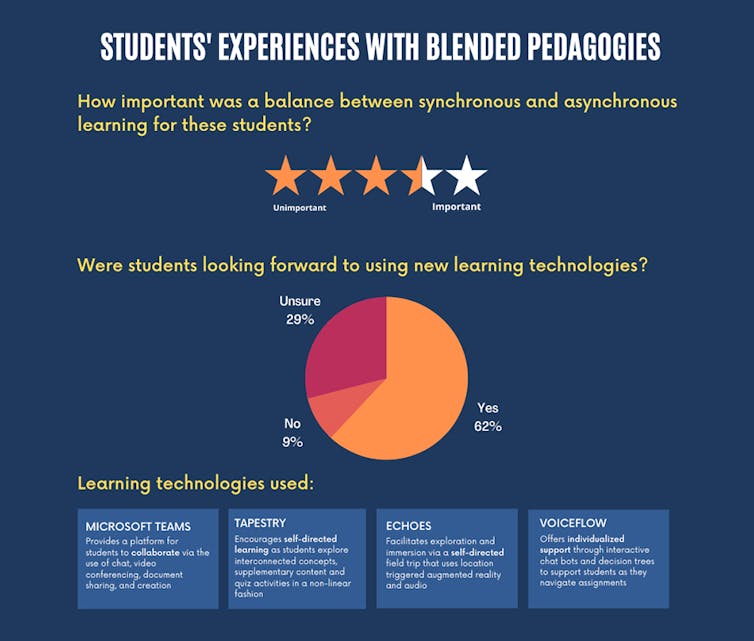Blended learning combines face-to-face and virtual instruction through the use of online learning technologies. Post-secondary students attend lectures in real-time, either virtually or in person, and this is accompanied by online learning activities completed outside of class time.
These blended classrooms can help support the educational needs of university students. When combined with traditional instruction, a judicious use of digital tools can encourage collaboration and personal responsibility for learning while allowing students to work at their own pace and adapt to rapidly changing technologies.
Incorporating technology into teaching and learning doesn’t mean throwing out previous approaches. The key is to adapt and create a new system of learning by designing classrooms that are more reflective of the world students will engage in once they graduate.
For universities to be more relevant to people’s daily lives, the walls of the university lecture room must be more porous, as students begin making critical connections between theory and application.
By adopting a blended approach to learning, educators support students’ transitions into the world of work, and how students draw upon and consolidate their learning in meaningful ways.

Best practices in blended learning
While many educators have embraced blended approaches to classroom design, this shifted to large-scale emergency remote teaching during the COVID-19 pandemic.
Some discussions about emergency remote learning in the pandemic focused on different online tools and how or whether these tools can compensate for the loss of regular in-person education.
But in ordinary times, and when relying on best blended learning practices, teaching approaches should be rooted in learning objectives or students’ experiences — and these considerations aren’t the same as whether course components are online or in-person.
Read more: Machines can't 'personalize' education, only people can
Embracing a creative and flexible approach to learning can enable a new ecosystem of learning to develop, but this should be supported, rather than defined by, an instructor’s mode of delivery.
We advocate for empowering students by helping them to learn how to use new digital technologies so they can critically integrate and construct new knowledge for themselves while communicating their thoughts with teachers and peers.
Students’ responses to a blended classroom
We conducted a survey of university students taking a first-year geography course at the University of British Columbia. Instructors used different platforms / softwares to support ways of teaching (pedagogies) in the classroom:
Microsoft Teams supported student collaboration by providing a platform through which they could co-create and share documents, or video-conference with one another;
Tapestry, a platform that allows professors to create dynamic websites that link together media to help students learn about interconnected concepts, encouraged students to engage in self-directed learning;
Through Echoes, we created self-directed field trips students could run on their mobile device, and we used this to encourage students to explore course concepts in their local community;
We used Voice Flow to support students through the interactive chat bots that could help them navigate topics (like plagiarism or developing term paper ideas).
Real-time and self-paced course components
An entry survey of 332 students revealed the majority of students had used learning technologies before — overwhelmingly for communication or accessing course materials.
Generally, they were excited by learning new technologies and eager to develop new expertise. However, a lack of experience was also a source of stress and anxiety for some students who were concerned these might require additional time to learn and navigate.

The exit survey of 189 participants showed a blended approach to learning gave students a strong motivation to learn while working at their own pace. Overwhelmingly, a balance of real-time (synchronous) and self-paced (asynchronous) delivery helped reinforce course learning objectives.
Students found all of the tools relatively easy to use. They rated Microsoft Teams, used to navigate arranging meeting times and work on a weekly shared assignment, as most challenging. We believe these challenges were due to the nature of group work and collaboration, as our past experience indicates no matter what tool is used, students usually struggle with group assignments. Yet students said the most common benefit of Microsoft Teams was collaboration and social interaction outside of class.

The results of the exit survey provided a heartening picture of how educational technologies can support more student independence and responsibility. Overall, students felt there was a good balance between asynchronous and synchronous learning, and this helped them make connections between lectures, assignments and course learning materials while collaborating.
Insights for designing a blended classroom
It’s important for instructors to choose digital tools that are easy to use and navigate;
A blended classroom should be student-centred. The tools used in our course allowed students to work at their own pace, improved their ability to collaborate and communicate with others, and encouraged them to explore course concepts more fully;
Instructors should choose digital tools that support course learning objectives. A common trap is adapting a course to a specific tool. But in a successfully blended classroom, digital tools should enhance learning rather than restrict it.
Consider how to enhance students’ ability to use different tools so that they can adapt to rapidly changing labour markets and classrooms.
A blended approach to teaching and learning does not mean less teaching because now technology does it. Rather, educational technology can help foster better learning environments, and more engaged and flexible ways of teaching.

